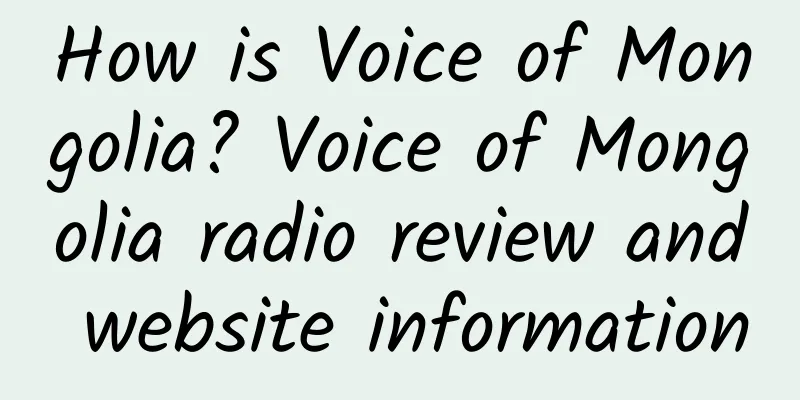How is Voice of Mongolia? Voice of Mongolia radio review and website information

|
What is Voice of Mongolia? Voice of Mongolia is a famous foreign radio station in Mongolia. It was founded in 1934 and renamed Ulaanbaatar Radio on January 29, 1965. It was renamed to its current name on January 1, 1997. The station broadcasts in Chinese, Russian, Mongolian, English, Japanese and Kazakh. Website: cn.vom.mn Voice of Mongolia Radio: History, Development and Global InfluenceVoice of Mongolia is one of the most influential foreign broadcasting media in Mongolia. Since its establishment in 1934, it has played an important role as a bridge between Mongolia and the world. As Mongolia's official foreign broadcasting station, Voice of Mongolia delivers Mongolian culture, history, news and development trends to global audiences in multiple languages. This article will explore the history, development process, language coverage and importance of Voice of Mongolia in global communication. 1. The History of Voice of MongoliaThe history of Voice of Mongolia dates back to 1934, when it was established as Mongolia's first radio station. Initially, the station's main mission was to broadcast news and cultural content to domestic audiences. As Mongolia's position on the international stage gradually rose, the station's mission also changed and began to take on the responsibility of external propaganda. On January 29, 1965, Voice of Mongolia was officially named "Ulaanbaatar Radio Station", which marked the beginning of a new stage of development for the radio station. During this period, the radio station's broadcast content gradually became richer, and its coverage also expanded to neighboring countries. On January 1, 1997, the radio station was renamed "Voice of Mongolia", a name that has been used to this day and has become an important symbol of Mongolia's external communication. 2. Language coverage of Voice of MongoliaVoice of Mongolia is well known for its multilingual broadcasts, currently broadcasting in six languages, including Chinese, Russian, Mongolian, English, Japanese and Kazakh. This multilingual strategy enables Voice of Mongolia to reach a wider audience, especially in Asia and Europe. 1. Chinese BroadcastChinese radio is an important part of Voice of Mongolia, mainly targeting listeners in China and its surrounding areas. Through Chinese radio, Voice of Mongolia introduces Mongolia's culture, history, economy and social development to Chinese listeners, and also provides an important platform for cultural exchanges between China and Mongolia. 2. Russian broadcastRussian-language radio is mainly aimed at listeners in Russia and its neighboring countries. Mongolia has a long historical relationship with Russia, and Russian-language radio not only helps Mongolia spread information in Russia and its neighboring countries, but also promotes political, economic and cultural exchanges between the two countries. 3. Mongolian broadcastingMongolian radio is the core content of Voice of Mongolia, which is mainly aimed at domestic listeners in Mongolia and overseas Mongolian groups. Through Mongolian radio, the radio station not only delivers domestic and international news information, but also strives to promote Mongolian language, culture and traditions. 4. English BroadcastEnglish broadcasts are an important window for Voice of Mongolia to reach global audiences. Through English broadcasts, Voice of Mongolia introduces Mongolia's unique culture, natural scenery and development achievements to English-speaking audiences around the world, and also provides an important channel for the international community to understand Mongolia. 5. Japanese broadcastJapanese broadcasts are mainly aimed at listeners in Japan and its surrounding areas. Mongolia and Japan have extensive cooperation in the fields of economy and culture. Japanese broadcasts not only help Mongolia spread information in Japan, but also promote friendly relations between the two countries. 6. Kazakh radioKazakh radio is mainly aimed at audiences in Kazakhstan and its neighboring countries. Mongolia and Kazakhstan have deep historical, cultural and linguistic ties, and Kazakh radio provides an important platform for cultural exchanges between the two countries. 3. The global influence of Voice of MongoliaAs Mongolia's official foreign radio station, Voice of Mongolia plays an important role in global communication. It not only conveys Mongolia's voice to the world, but also promotes cultural exchanges and understanding between Mongolia and other countries through multilingual broadcasting. 1. Promote cultural exchangeThe Voice of Mongolia introduces Mongolia's unique culture, history and traditions to global audiences through its multilingual broadcasts. Whether it is Mongolia's traditional music, dance, or its rich natural landscape, the Voice of Mongolia delivers these contents to listeners around the world through radio programs, promoting the global dissemination of Mongolian culture. 2. Strengthening international relationsVoice of Mongolia has played an important role in promoting friendly relations between Mongolia and other countries. Through its radio programs, Voice of Mongolia not only introduces Mongolia's development achievements to the international community, but also provides an important platform for political, economic and cultural exchanges between Mongolia and other countries. 3. Enhance the country’s imageThe Voice of Mongolia has shown Mongolia's achievements in modernization to global audiences through its high-quality radio programs. Whether it is Mongolia's economic growth, social progress, or its efforts in environmental protection, the Voice of Mongolia has conveyed these contents to the international community through radio programs, thus enhancing Mongolia's national image. IV. Future Development of Voice of MongoliaWith the continuous advancement of global communication technology, Voice of Mongolia is also actively exploring new development paths. In the future, Voice of Mongolia will continue to convey Mongolia's voice to the world through multilingual broadcasting, and will also use emerging communication platforms such as the Internet and social media to expand its global influence. 1. Digital transformationThe Voice of Mongolia is actively promoting digital transformation, providing more convenient radio services to global listeners through platforms such as the Internet and mobile applications. In the future, the Voice of Mongolia will further strengthen the construction of its online radio platform to provide richer radio content for global listeners. 2. Social media communicationThe Voice of Mongolia will also use social media platforms to expand its global reach. By publishing radio content on social media platforms such as Facebook, Twitter, and YouTube, the Voice of Mongolia will be able to attract more young listeners and further enhance its global influence. 3. International cooperationIn the future, Voice of Mongolia will continue to strengthen cooperation with broadcasting organizations in other countries and further enhance its global communication capabilities through joint production of radio programs, hosting international cultural exchange activities, and other means. V. ConclusionAs Mongolia's official foreign radio station, Voice of Mongolia has been playing an important role in connecting Mongolia with the world since its establishment in 1934. Through its multilingual broadcasts, Voice of Mongolia conveys Mongolia's culture, history and development achievements to global audiences, while also promoting cultural exchanges and understanding between Mongolia and other countries. In the future, Voice of Mongolia will continue to further enhance its global influence through digital transformation, social media communication and international cooperation, and convey more voices from Mongolia to the world. The website of Voice of Mongolia is: cn.vom.mn. Listeners around the world are welcome to visit and learn more about Mongolia. |
<<: How is UOL Mail? UOL Mail review and website information
>>: How is Futoli? Futoli review and website information
Recommend
How is the University of Parma? University of Parma reviews and website information
What is the website of the University of Parma? Th...
Effects and functions of hot winter fruit
Have you ever eaten hot winter fruit? I believe t...
The efficacy and function of pepper water The medicinal value of pepper water
Everyone must have seen pepper water, and know th...
The efficacy and function of lotus root
Lotus root is a kind of vegetable that we often t...
How to store broad beans?
Today I will tell you how to better store broad b...
How to cook ten-grain porridge? The correct way to cook ten-grain porridge
Ten-grain porridge is a traditional Chinese healt...
How to make delicious chicken soup Steps and steps tutorial
Many people like to drink chicken soup, and the d...
How is MSN France? MSN France reviews and website information
What is MSN France? MSN France is the French branc...
What is Virgin Galactic like? Virgin Galactic reviews and website information
What is Virgin Galactic? Virgin Galactic is a spac...
The efficacy and contraindications of leek
[Aliases of leeks] Yellow chives, white chives, l...
Homerton College, University of Cambridge
What is the website of Homerton College, Universit...
Benefits of Barley and Red Bean Porridge
Do you know the effects of barley and red bean po...
How is the Polish Savings Bank? Polish Savings Bank Reviews and Website Information
What is the website of Polish Savings Bank? Polish...
Pig's Ear Grass
Pig's ear grass is a perennial herb, up to 10...
How is Claremont McKenna College? Claremont McKenna College reviews and website information
What is Claremont McKenna College? Claremont McKen...









